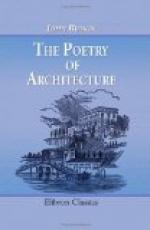52. The door is flanked and roofed by three large oblong sheets of gray rock, whose form seems not to be considered of the slightest consequence. Those which form the cheeks of the windows are generally selected with more care from the debris of some rock, which is naturally smooth and polished, after being subjected to the weather, such as granite or syenite. The window itself is narrow and deep set; in the better sort of cottages, latticed, but with no affectation of sweetbrier or eglantine about it. It may be observed of the whole of the cottage, that, though all is beautiful, nothing is pretty. The roof is rather flat, and covered with heavy fragments of the stone of which the walls are built, originally very loose; but generally cemented by accumulated soil, and bound together by houseleek, moss, and stonecrop: brilliant in color, and singular in abundance. The form of the larger cottages, being frequently that of a cross, would hurt the eye by the sharp angles of the roof, were it not for the cushion-like vegetation with which they are rounded and concealed. Varieties of the fern sometimes relieve the massy forms of the stonecrop, with their light and delicate leafage. Windows in the roof are seldom met with. Of the chimney I shall speak hereafter.
53. Such are the prevailing peculiarities of the Westmoreland cottage. “Is this all?” some one will exclaim: “a hovel, built of what first comes to hand, and in the most simple and convenient form; not one thought of architectural beauty ever coming into the builder’s head!” Even so; to this illustration of an excellent rule, I wished particularly to direct attention: that the material which Nature furnishes, in any given country, and the form which she suggests, will always render the building the most beautiful, because the most appropriate. Observe how perfectly this cottage fulfills the conditions which were before ascertained to be necessary to perfection. Its color is that of the ground on which it stands, always subdued and gray, but exquisitely rich, the color being disposed crumblingly, in groups of shadowy spots; a deep red brown, passing into black, being finely contrasted with the pale yellow of the Lichen geographicus, and the subdued white of another lichen, whose name I do not know; all mingling with each other as on a native rock, and with the same beautiful effect: the mass, consequently, at a distance, tells only as a large stone would, the simplicity of its form contributing still farther to render it inconspicuous. When placed on a mountain-side such a cottage will become a point of interest, which will relieve its monotony, but will never cut the hill in two, or take away from its size. In the valley, the color of these cottages agrees with everything: the green light, which trembles through the leafage of the taller trees, falls with exquisite effect on the rich gray of the ancient roofs: the deep pool of clear water is not startled from its peace by their reflection; the ivy, or the creepers to which the superior wealth of the peasant of the valley does now and then pretend, in opposition to the general custom, cling gracefully and easily to its innumerable crevices; and rock, lake, and meadow seem to hail it with a brotherly affection, as if Nature had taken as much pains with it as she has with them.




